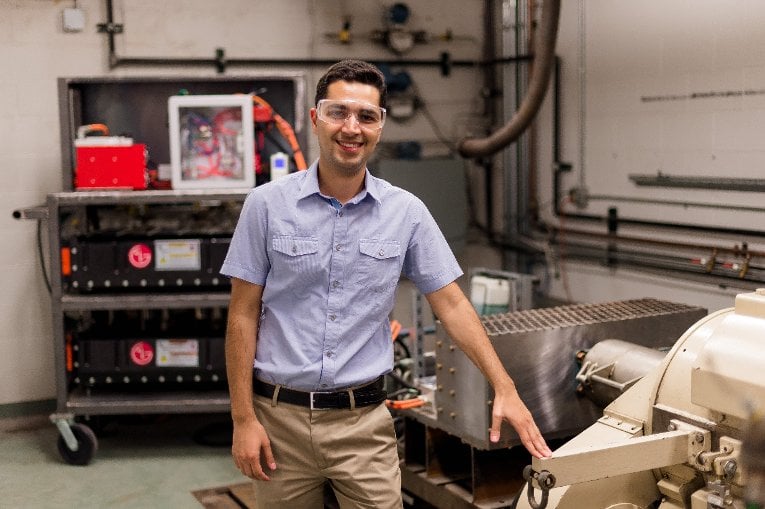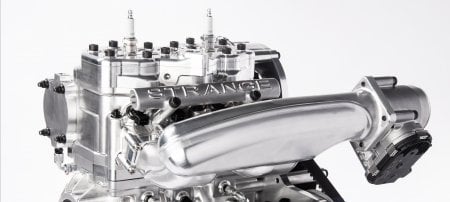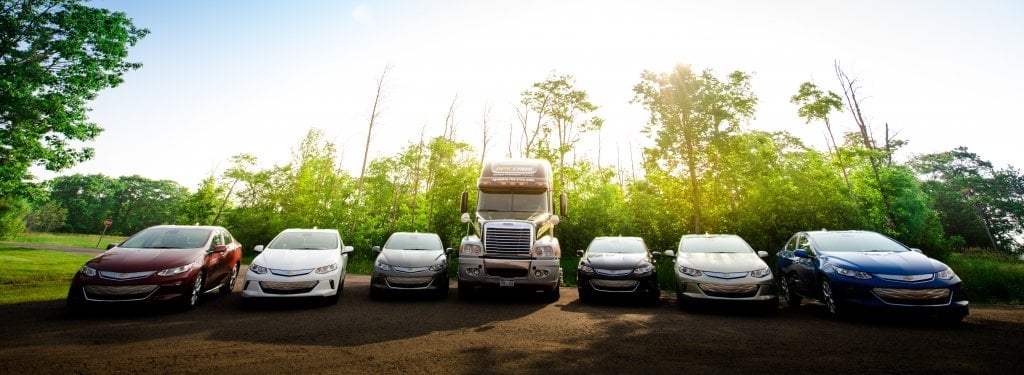Ali Solouk received an SAE International best presentation and dean’s outstanding research scholar awards for his research on integrating high efficiency engines with electrified powertrain technology.
Ali Solouk might not wear a large red cape or fly around the city fighting crime, but in the world of hybrid electric vehicles, Solouk is a superhero paving the way for a greener earth.
As a mechanical engineering PhD graduate, Solouk conducted research into integrating low temperature combustion engines and advanced electrified powertrain systems at Michigan Technological University. In other words, he has helped build vehicles that consume less fuel and save money.
Past Experience
Growing up, Solouk spent much of his time enjoying the beauty of the outdoors by camping, hiking and climbing. Much of this changed, however, when he left his hometown, Khorram Abad, located in western Iran, to begin his education at K. N. Toosi University in Tehran.
“The first month I got there, as a person who had grown in a small town, I started feeling vertigo and dizziness, and I found it was the air pollution,” Solouk says, explaining that most of the locals didn't realize the effects of Tehran’s pollution, even on so-called clean days, because they were used to it. “That inspired me to go in this direction, to see what the options are to protect the environment and reduce the health risks associated with the air pollution.”
This passion led Solouk to mechanical engineering, and he saw its influence on changing the environment. Solouk says he focuses on the transportation sector since it is one of the major energy consumers—accounting for 28 percent of the total energy consumption in the US in 2015, according to the US Energy Information Administration—as well as a producer of harmful emissions. By reducing emissions and increasing the efficiency of vehicles and engines, Solouk hopes to reduce pollution.
Present Research
To understand a low temperature combustion engine, start with how traditional engine systems operate. The process can be broken down into four main parts: intake, compression, combustion and exhaust. Basically, gas and air are compressed so that, when sparked, the fuel ignites, creating combustion to power the engine. This process repeats thousands of times per minute within the engine to power anything from lawnmowers to buses.
Low temperature combustion engines are a compromise. They have high fuel efficiency but limited operating range; by using a secondary source of electrical energy like the vehicle's battery, the engine’s operating range can be expanded. What makes Solouk’s work so challenging is finding the right balance. He has to determine the optimum combination of the electrical power level and powertrain architecture for the low temperature combustion engine to maximize the vehicle’s efficiency.
“How do you distribute energy between the two different sources of energy? One source is the electric battery, which is connected to the motor, and the other is fuel which will power the engine,” Solouk says, explaining that the control systems he works on anticipate drawing power from each, and the decision to switch between the two—and optimize fuel efficiency—is informed by the engine cycles, driving time and speed.
"You still need to refuel your tank, but you will burn less gas than conventional cars and compared to current hybrid electric cars."
To increase the efficiency, Solouk experimented with low temperature combustion and its significance in the system by building a test setup at Advanced Power Systems Lab at Michigan Tech. Low temperature combustion engines are more efficient than traditional combustion found in both standard and hybrid engines for two reasons: less heat is lost to an outside system during combustion and the air-fuel mixture in an engine with a higher compression ratio is leaner compared to that of conventional spark ignition engines. This means that the engine stays cooler while working just as hard.
“Low temperature combustion engines represent frontiers of the research for high-efficiency internal combustion engines with low emissions,” says Mahdi Shahbakhti, an assistant professor of mechanical engineering and Solouk’s advisor. “These engines have been of high interest for the US Department of Energy due to their promise.”
Solouk's research results were used as supporting materials for a new $2.8 million grant from the Department of Energy that Shahbakhti is leading.
Future Innovation
Solouk says the solution to fuel economy efficiency will not appear overnight; there is no magic formula. He hopes automotive companies keep investing in improving electrified powertrain and hybrid technologies.
“I would like to see auto companies try to embrace using high efficiency engines in the electrified powertrain and have it in their pipeline for future production; this will help to improve powertrain efficiency in a cost-effective manner,” Solouk says.
He has boots on the ground for this goal and just started working at Ford this winter, where he looks to further his research into hybridized low temperature combustion engines. Solouk adds that he sees a good chance of using the low temperature combustion engines in the automotive industry because the powertrain electrification cost has decreased significantly over the past decade.
"We have been one of the first research teams to study multi-mode low temperature combustion/spark-ignition engines in the electrified powertrain," Solouk says, adding that his experience at a recent SAE world congress inspired him to up his efforts. He noticed an increase in auto industry potential investments for integrating high-efficiency engines with the electrified powertrain. "These engines can financially improve the hybrid electric vehicle fuel economy and can act as a bridging technology for a fully electric vehicle fleet until when the battery technology becomes cheaper, the battery charging infrastructure becomes more accessible and the electric power generation cycle becomes cleaner."
Michigan Technological University is a public research university founded in 1885 in Houghton, Michigan, and is home to more than 7,000 students from 55 countries around the world. Consistently ranked among the best universities in the country for return on investment, Michigan’s flagship technological university offers more than 120 undergraduate and graduate degree programs in science and technology, engineering, computing, forestry, business and economics, health professions, humanities, mathematics, social sciences, and the arts. The rural campus is situated just miles from Lake Superior in Michigan's Upper Peninsula, offering year-round opportunities for outdoor adventure.







Comments